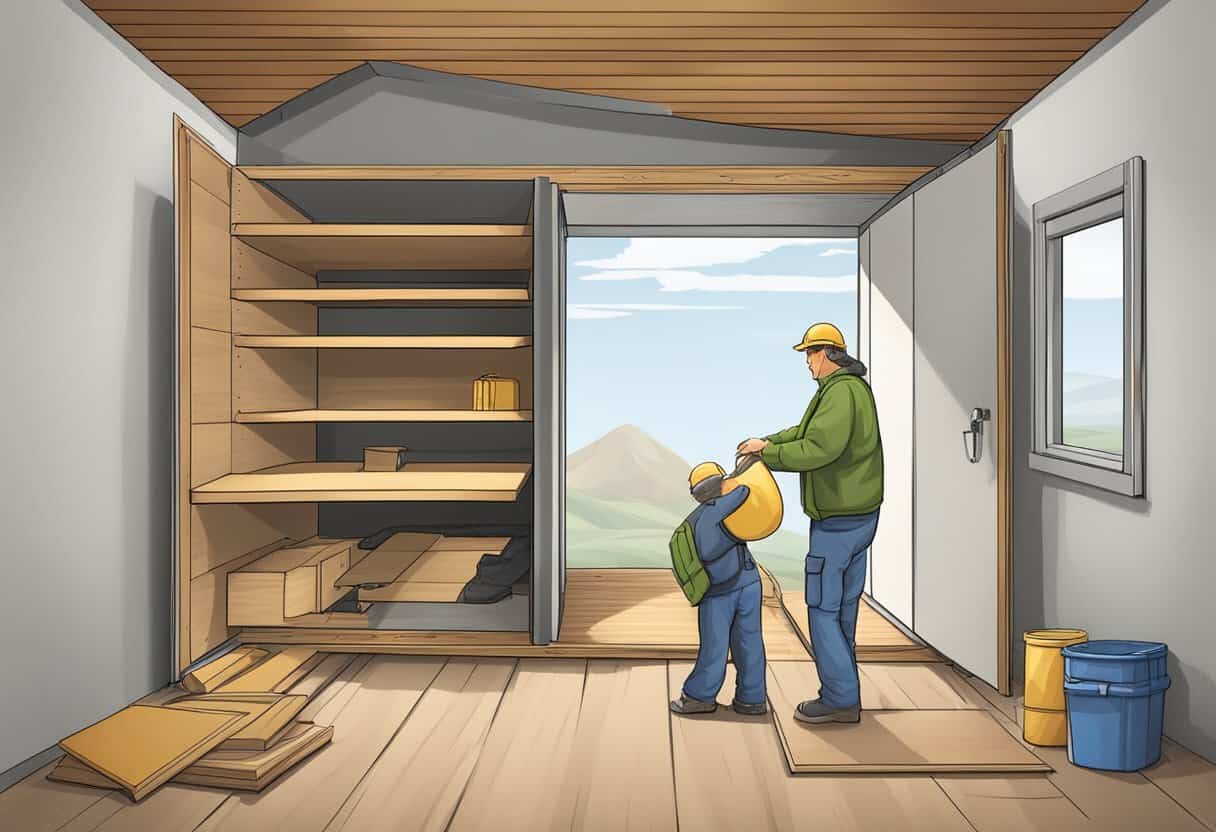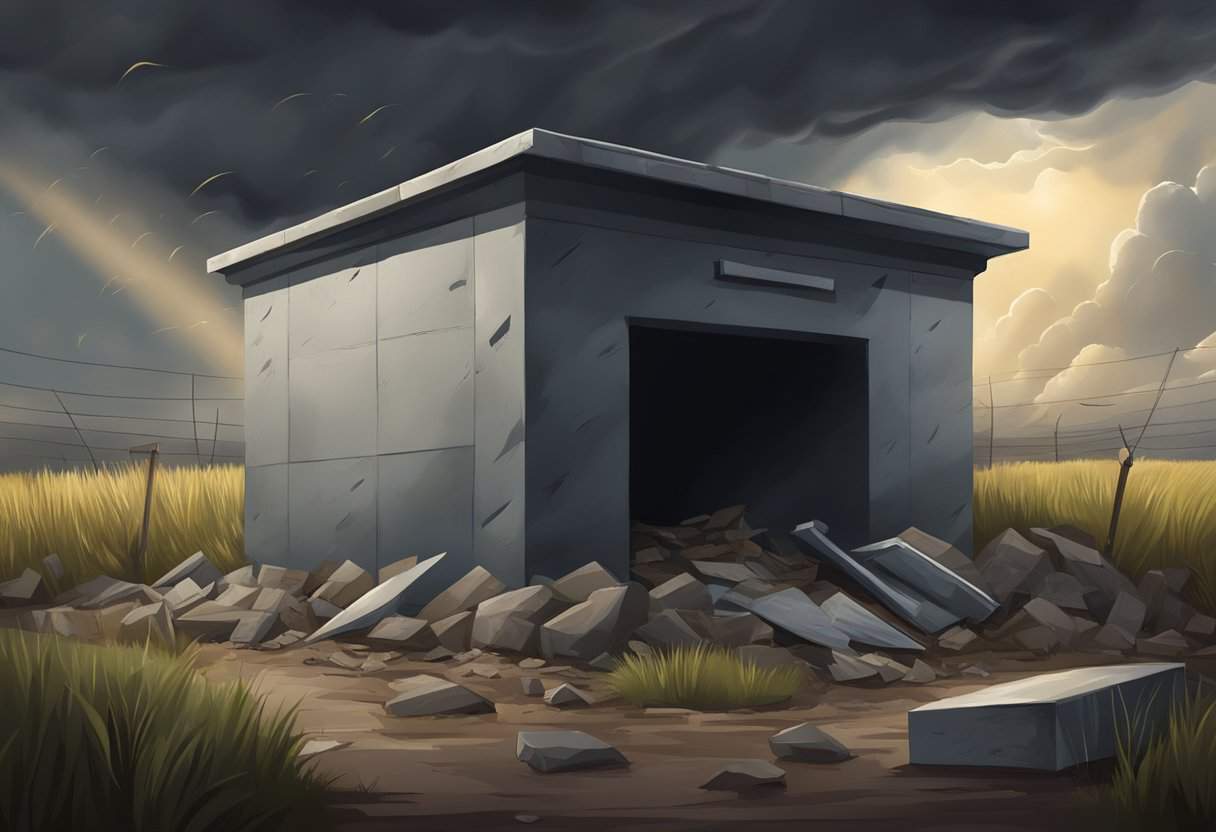Creating a DIY tornado shelter in your home can be a lifesaving project.
Tornados strike with little warning, delivering devastating winds that can demolish structures in their path. By building your own shelter, you have the assurance of a safe space when severe weather threatens. It’s essential to understand tornado dynamics and the engineering behind effective storm shelters before you begin.
Building a DIY tornado shelter requires meticulous planning and adherence to safety guidelines. You must choose the right location, design for durability and strength, and use proper construction techniques to ensure your shelter can withstand extreme forces. Regular maintenance and knowledge of safety procedures for occupants are crucial once your shelter is operational.
Additionally, for homes with existing structures, retrofitting might be a viable option to convert a space into a reinforced safe area.
Building a DIY tornado shelter involves meticulous planning, choosing a robust location, utilizing durable materials, and adhering to safety codes. Regular maintenance and clear safety procedures ensure effectiveness. Understanding tornado dynamics and shelter engineering is crucial for creating a safe refuge during severe weather.
Understanding Tornadoes and Storm Shelters
When considering the construction of a DIY Tornado Shelter, it’s essential to comprehend the nature of tornadoes. A tornado is a violent, rotating column of air extending from a thunderstorm to the ground. They are capable of producing high-velocity winds exceeding 200 mph, causing extensive damage to structures and posing significant risks to life and property.
Tornadoes can occur in many parts of the world but are most frequent in the United States, especially in “Tornado Alley.” They are often spawned from severe storms and can appear with little warning. Understanding the weather patterns that lead to tornadoes can aid in early preparation.
Regarding storm shelters, they are engineered structures designed to withstand the extreme conditions generated by tornadoes and other natural disasters. These shelters can be built above ground or below ground, and should be constructed according to specifications that meet or exceed FEMA P-320 guidelines for storm shelters.
Here’s why storm shelters are vital:
- Protection: Safeguard against deadly high-velocity winds and debris.
- Accessibility: Ideally situated close to your residence for quick access.
- Peace of mind: Knowing you have a secure place during a tornado.
Your DIY tornado shelter should be anchored firmly to resist overturning or uplift. Materials such as reinforced concrete or steel are commonly used for their strength and durability. The shelter needs to be well-ventilated, have a sturdy door that opens inward, and contain an adequate supply of emergency essentials.
In regions susceptible to both tornadoes and hurricanes, storm shelters provide a dual function. However, each natural disaster has distinct characteristics, necessitating that shelters meet the specific safety standards for the types of severe storms expected in your area.
Constructing a storm shelter is a considerable task that requires careful planning and adherence to safety standards. It’s critical to ensure that your DIY project is up to the challenge of protecting you from these unpredictable and powerful forces of nature.
Planning Your DIY Tornado Shelter
When considering the construction of a DIY tornado shelter, careful planning is essential. This includes selecting a robust location, calculating precise size specifications, choosing durable materials, and understanding the regulatory requirements. Let’s walk through the critical steps to ensure your shelter is safe and effective.
Assessing the Proposed Location
Your DIY tornado shelter should be situated in a spot that minimizes exposure to flying debris and high winds. Ideal locations could be the basement, garage, or an interior room that doesn’t share walls with the outside. For homes without a basement, a closet or bathroom at the center of the house provides the next best protection.
Determining the Size and Space Requirements
Consider the size of your household when determining the dimensions of your shelter. FEMA recommends 3 square feet per person for standing room. Factor in floor space for seating, storage, and necessary supplies. The shelter should be spacious enough for easy entry and mobility.
Selecting the Right Materials
The integrity of your shelter rests on the materials you choose. Reinforced concrete, 14-gauge steel, and reinforced concrete block are among the most durable choices. For an above-ground shelter, heavy-duty steel sheets offer resistance to winds and debris.
Budget Considerations
Keep in mind the cost of materials and potential labor. Accurately estimating the budget helps prevent overspending. If you have a tight budget, consider cost-effective materials such as plywood or concrete block that still meet safety requirements.
Safety and Accessibility
Your shelter must be readily accessible during an emergency. Ensure the door assembly is robust with heavy-duty hinges and can be bolted down for safety from extremely strong winds. Accessibility for all household members, including those with disabilities, is mandatory.
Understanding FEMA and Other Building Codes
Familiarize yourself with FEMA P-320 guidelines and the National Storm Shelter Association standards which offer specifications to ensure the shelter can withstand tornado conditions. Compliance with these codes not only ensures safety but may also be required for certain funding grants.
Dealing with Potential Flooding
If your location is prone to flooding, consider an above-ground shelter. Ensure waterproofing measures are in place, and include a sump pump in your construction plans if installing an underground shelter.
Procuring Necessary Supplies
Gather all supplies necessary for construction. This may include a steel door, hinges, fastening systems, and tools for assembly. For an accurate list, it is best to refer to a trusted construction plan that meets FEMA requirements.
Evaluating Prefabricated vs. Homemade Options
Prefabricated storm shelters can be more convenient but also more expensive. Weigh the pros and cons of a homemade shelter, where you may have more control over customization, versus a prefabricated model, which is designed to meet established safety criteria.
Securing Funding and Grants
Investigate available funding grants which can significantly reduce the financial burden. FEMA, local government programs, and other entities may offer financial assistance especially in wind zones most susceptible to tornadoes.
Design and Construction

When constructing a DIY tornado shelter, your primary concerns are ensuring the structure’s integrity and safety. This involves detailed design specifications, selection of robust materials, and adherence to construction best practices mandated for extreme weather conditions.
Outlining Design Specifications
Begin by designing your shelter to withstand tornado force winds. If you’re in Tornado Alley, it’s imperative that the design can endure high-speed winds and flying debris. The design should include a concrete slab foundation, reinforced walls, and a sturdy roof. Think about whether you want an above-ground or basement shelter, and plan for the weight and impact the structure must withstand.
Creating a Solid Foundation
Pour a concrete slab foundation, ensuring it’s thick enough to anchor the shelter securely. Use heavy-duty anchor bolts embedded into the concrete to fasten the walls firmly, preventing the structure from being displaced during a tornado.
Constructing Walls and Roof
The shelter’s walls and roof should be constructed from reinforced concrete or steel to offer the best protection. Each should be able to resist debris impact, with walls at least 4 inches thick. The roof, also heavily reinforced, must be able to support the weight of any debris that might fall onto it.
Reinforcing Structure Against High Winds
Reinforce your structure to tolerate high winds. This may involve using additional steel rebar in the concrete or steel sheathing on the walls. Ensure all parts of the shelter are secured tightly to each other to prevent separation during a tornado.
Installing Doors and Ventilation
Install a steel door with heavy-duty hinges that opens inward to prevent debris from blocking your exit. The door should be able to latch securely. Proper ventilation is imperative to avoid suffocation – make sure to include vents that can shut to prevent debris from getting inside.
Final Touches and Inspection
After construction, inspect every element of the shelter meticulously. Check for cracks in the foundation and walls, ensure the door seals properly, and confirm that vents are operational. Your safety during a tornado depends on the reliability of this structure, so all final touches and inspections should be thorough.
DIY Construction Techniques
In this section, you’ll learn specific, reliable methods for constructing a DIY tornado shelter, focusing on strength and safety. Each technique is designed to enhance the durability of your shelter.
Building With Concrete Blocks
Concrete blocks are a fundamental component for any sturdy shelter. You begin by laying a concrete floor as a solid foundation. The walls are then erected by stacking and bonding concrete blocks, carefully ensuring that each layer is level.
Wooden Form and Framing
For the internal framework, wooden forms made from sturdy wood boards like 2x4s provide a skeleton for your shelter. This structure not only shapes the shelter but also supports the walls during the concrete pouring and setting process.
Enhancing Stability with Metal Rebar
Metal rebar is essential for reinforcing the structure. Integrate it within the concrete block walls by leaving spaces within the blocks, positioning the rebar vertically, and filling with concrete. This adds considerable stability and resilience against severe storms.
Applying Reinforced Concrete
Build upon your base by applying poured reinforced concrete over the wooden framing. Ensure to create a dense mesh of metal rebar within the mixture before it sets to increase the tensile strength of the walls, making them impact-resistant.
Erecting Steel Structures
Finally, for ultimate fortification, you can opt to erect walls using steel sheets reinforced by welded solid steel frames. This method ensures that your shelter is anchored firmly to the foundation and can withstand powerful winds and debris impact.
Shelter Maintenance and Upkeep
Maintaining your DIY tornado shelter is crucial for ensuring its reliability and safety in times of need. Regular upkeep involves a systematic approach that includes inspection, maintenance, and addressing any issues promptly.
Inspection
It’s essential to conduct bi-annual inspections of your shelter, preferably in the spring and fall. Your checklist should include:
- Structural Integrity: Examine the shelter for any signs of damage such as cracks, rust, or corrosion.
- Door Operation: Ensure the door swings freely and seals tightly.
- Ventilation System: Check that air vents are unobstructed and functional.
Maintenance
Maintenance tasks are necessary to keep your tornado shelter in optimal condition:
- Lubricate Hinges and Locks: Apply lubricant to prevent rust and ensure smooth operation.
- Clean Interior and Exterior: Remove debris and dirt that could affect the shelter’s integrity or cause blockages.
- Sealant Application: Reapply waterproof sealants as needed to prevent leaks.
Upkeep
Regular upkeep preserves the long-term viability of your shelter:
- Replace Worn Parts: Swap out any components that show excessive wear.
- Update Emergency Supplies: Keep your stock of water, food, and first-aid items current.
- Documentation: Keep a log of all maintenance activities for future reference.
By following these guidelines, you’ll ensure that your tornado shelter remains dependable and ready to provide protection when it matters most.
Ensuring the Safety of Occupants
When constructing a DIY tornado shelter, your primary concern is the safety of those who will use it. A comprehensive approach to safety involves several key aspects, including the selection of location, structural integrity, and preparedness.
Choose an Independent Interior Room
Ideally, your tornado shelter should be situated on the lowest level of your home. If you are retrofitting an existing room, consider using an interior room with no windows, as this reduces the risk from flying debris. Basements are typically preferred, but if your home does not have one, a small room at the center of the house, like a bathroom or closet, can also serve as a safe room.
Structural Considerations
Building a safe room within your home requires sturdy materials capable of withstanding extreme winds and debris impacts. Use this table to identify the basic structural elements needed:
| Component | Suggested Material | Purpose |
|---|---|---|
| Walls | Reinforced concrete, steel, or plywood | To withstand high winds and protect against debris |
| Door | Steel or reinforced wood | Must resist wind pressure and debris penetration |
| Anchoring | Heavy-duty bolts, anchoring systems | To secure the shelter to the foundation, avoiding uplift and overturning |
Safety Features Inside the Shelter
Within your shelter, store emergency supplies such as water, non-perishable food, a first-aid kit, a flashlight, and a weather radio. Ensure that the space can be comfortably used for several hours if needed.
Regular Maintenance and Drills
Conduct regular maintenance checks on the shelter to ensure it remains reliable. Hold drills so all household members know where to go and what to do when a tornado warning is issued.
By paying close attention to these details, your DIY tornado shelter will provide a robust level of safety for yourself and your loved ones during severe storms.
Retrofitting Existing Structures
When considering a DIY approach to retrofitting your home for tornado safety, a cost-effective strategy is to reinforce an existing part of your home. Creating a sturdy shelter within your basement, garage, or even a bathroom or closet, requires attention to certain structural details.
If you have a basement, start by reinforcing the walls with plywood or steel panels. Secure them to the walls with long bolts and confirm the stability of the ceiling above. To ensure safety, all materials should adhere to FEMA’s guidelines for wind resistance.
In homes without a basement, using a garage for a tornado safe area can be viable. Reinforce a small section, ideally a corner away from windows, by constructing a steel frame structure. It’s crucial to use heavy bolts and create a strong connection to the foundation of your house.
For homes with limited space, transform a bathroom or closet into a shelter by reinforcing the existing walls and ceiling. A central location is preferable to minimize the risk of exterior wall collapse. Here’s a simplified checklist:
- Select an interior room with no windows and minimal exterior walls.
- Strengthen walls with additional layers of wood or steel.
- Secure the ceiling with steel cables or strong straps attached to the main structure.
When undertaking a DIY project, always consult with a structural engineer to validate your retrofitting plans and ensure they are up to code.
For detailed guidelines, review the study on in-residence hurricane and tornado shelters, highlighting the recommended practices for retrofitting existing homes to protect against severe windstorms.
Conclusion
When considering the construction of a DIY tornado shelter, safety should be your paramount concern. Ensure that your shelter adheres to Federal Emergency Management Agency (FEMA) guidelines to maximize protection during severe storms.
- Research Properly: Inform yourself about the required specifications for tornado-resistant structures.
- Materials Matter: Use only high-quality, impact-resistant materials capable of withstanding high winds and flying debris.
Building a DIY tornado shelter can be cost-effective and empowering, but it’s imperative to remember that this is a project where cutting corners can have dire consequences. If you’re not experienced in construction, seeking professional help or advice is highly advisable.
Remember to equip your shelter with necessary emergency supplies:
- First aid kit
- Flashlights and extra batteries
- Whistle to signal for help
- Portable NOAA Weather Radio for updates
Review and practice emergency plans with everyone in your household. Your DIY tornado shelter should offer a secure space, giving you peace of mind that should a tornado occur, you and your loved ones have a safe retreat.
Frequently Asked Questions
Creating a tornado shelter demands careful adherence to established safety guidelines. This section addresses your concerns by providing specific, actionable information.
What are the recommended specifications for a DIY storm shelter according to FEMA guidelines?
The Federal Emergency Management Agency (FEMA) recommends that DIY storm shelters be built to withstand winds up to 250 miles per hour and be sufficiently anchored to resist overturning or uplift.
How can one build a cost-effective underground storm shelter on a budget?
To build a cost-effective underground storm shelter, utilize economical materials such as reinforced concrete or modified shipping containers and perform some of the labor yourself, if you have construction experience.
What steps are involved in constructing a safe room inside a closet for tornado protection?
Constructing a safe room inside a closet involves reinforcing the walls and door with steel or plywood, anchoring the structure to the foundation of your home, and ensuring that it has no windows.
Are there any reliable DIY storm shelter kits available for home assembly?
Yes, there are DIY storm shelter kits available that provide the necessary materials and instructions for home assembly, ensuring that the finished product complies with safety standards.
What considerations should be taken into account when converting a shipping container into a tornado shelter?
When converting a shipping container into a tornado shelter, it’s essential to reinforce the structure, install proper ventilation, and secure it to a concrete foundation to prevent displacement.
What are the necessary precautions to ensure a self-built tornado shelter is structurally sound and safe?
Ensure your self-built tornado shelter is structurally sound by using reinforced concrete or steel, securing it adequately to resist uplift, and following local building codes and FEMA guidelines for construction. Regular maintenance and inspections are also crucial to maintain safety.







